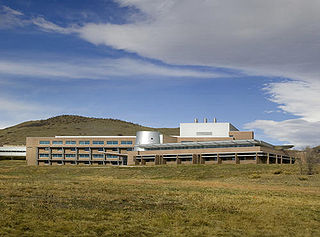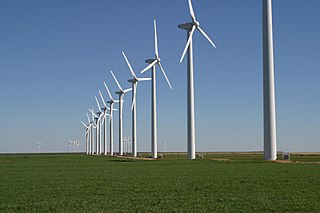Related Research Articles

The National Renewable Energy Laboratory (NREL) in the US specializes in the research and development of renewable energy, energy efficiency, energy systems integration, and sustainable transportation. NREL is a federally funded research and development center sponsored by the Department of Energy and operated by the Alliance for Sustainable Energy, a joint venture between MRIGlobal and Battelle. Located in Golden, Colorado, NREL is home to the National Center for Photovoltaics, the National Bioenergy Center, and the National Wind Technology Center.
The Cape Wind Project was a proposed offshore wind energy project on Horseshoe Shoal in Nantucket Sound off Cape Cod, Massachusetts. It was projected to generate 1,500 gigawatt hours of electricity a year at a first-dollar cost of $2.6 billion.

Wind power is a branch of the energy industry that has expanded quickly in the United States over the last several years. From January through December 2022, 434.8 terawatt-hours were generated by wind power, or 10.25% of electricity in the United States. The average wind turbine generates enough electricity in 46 minutes to power the average American home for one month. In 2019, wind power surpassed hydroelectric power as the largest renewable energy source in the U.S.

According to data from the US Energy Information Administration, renewable energy accounted for about 13.1% of total primary energy consumption and about 21.5% of total utility-scale electricity generation in the United States in 2022.

Community wind projects are locally owned by farmers, investors, businesses, schools, utilities, or other public or private entities who utilize wind energy to support and reduce energy costs to the local community. The key feature is that local community members have a significant, direct financial stake in the project beyond land lease payments and tax revenue. Projects may be used for on-site power or to generate wholesale power for sale, usually on a commercial-scale greater than 100 kW.
New York has 2,192 MW of installed wind power capacity as of 2022. Most of New York's wind power is located in upstate New York as onshore wind farms. New York has set a goal of developing 9,000 MW of offshore installed wind power capacity by 2035 that will power an estimated 6 million homes. As of October 2022, New York has five offshore wind farms in development with approximately 4,300 MW installed capacity.
Ørsted U.S. Offshore Wind is an offshore wind energy development group that is affiliated with Ørsted, a Danish firm. It is joint headquartered in Boston, Massachusetts and Providence, Rhode Island. As of 2019, it was involved in some of the largest offshore wind farm projects in the United States.

A community solar project, farm or garden is a solar power installation that accepts capital from and provides output credit and tax benefits to multiple customers, including individuals, businesses, nonprofits, and other investors. Participants typically invest in or subscribe to a certain kW capacity or kWh generation of remote electrical production. The project's power output is credited to investors or subscribers in proportion to their investment, with adjustments to reflect ongoing changes in capacity, technology, costs and electricity rates. Community solar provides direct access to the renewable energy to customers who cannot install it themselves. Companies, cooperatives, governments or non-profits operate the systems.

The U.S. state of Massachusetts has vast wind energy resources offshore, as well as significant resources onshore. The 2016 update to the states's Clean Energy and Climate Plan had a goal of reducing 1990 baseline greenhouse gas emissions levels by 25% by 2020. Current goals include installing 3,500 megawatts (MW) of offshore wind power in the state by 2035. However, as of Q4 2021 the state had only 120 MW of wind powered electricity generating capacity, responsible for generating 0.9% of in-state electricity production. The state has awarded contracts to two offshore projects, the 800 MW Vineyard Wind project and 804 MW Mayflower Wind project. Construction began on the Vineyard Wind 1 project on November 18, 2021, after a long fight for approval. Commonwealth Wind was selected for development in 2021, but the developer has attempted to cancel the project due to increased costs. There are eight projects planned for off the southern coast of Massachusetts, though some will deliver power to Rhode Island, Connecticut, and New York.

Wind Powering America (WPA) is an initiative of the United States Department of Energy (DOE) that seeks to increase the use of wind energy throughout the United States. WPA collaborates with key state and regional stakeholders, including farmers, ranchers, Native Americans, rural electric cooperatives, consumer-owned utilities, and schools to break down barriers associated with wind energy development.
Modern United States wind energy policy coincided with the beginning of modern wind industry of the United States, which began in the early 1980s with the arrival of utility-scale wind turbines in California at the Altamont Pass wind farm. Since then, the industry has had to endure the financial uncertainties caused by a highly fluctuating tax incentive program. Because these early wind projects were fueled by investment tax credits based on installation rather than performance, they were plagued with issues of low productivity and equipment reliability. Those investment tax credits expired in 1986, which forced investors to focus on improving the reliability and efficiency of their turbines. The 1990s saw rise to a new type of tax credit, the production tax credit, which propelled technological improvements to the wind turbine even further by encouraging investors to focus on electricity output rather than installation.

Wind power in Hawaii has the potential to provide all of the electricity generation in the electricity sector in Hawaii. The 132 commercial wind turbines in the state have a total capacity of 236 MW. In 2015, wind turbines produced 6.4% of Hawaii's electricity. In 2012, Hawaii generated 367 million kWh from wind power.

Renewable energy in Afghanistan includes biomass, geothermal, hydropower, solar, and wind power. Afghanistan is a landlocked country surrounded by five other countries. With a population of less than 35 million people, it is one of the lowest energy consuming countries in relation to a global standing. It holds a spot as one of the countries with a smaller ecological footprint. Hydropower is currently the main source of renewable energy due to Afghanistan's geographical location. Its large mountainous environment facilitates the siting of hydroelectric dams and other facets of hydro energy.

Wind power in Virginia is in the early stages of development. In March 2015, Virginia became the first state in the United States to receive a wind energy research lease to build and operate offshore wind turbines in federal waters. Virginia has no utility scale wind farms.
South Fork Wind Farm is a utility-scale offshore wind farm project on the Outer Continental Shelf Offshore Rhode Island (RI) which will provide energy to New York state.
Vineyard Wind 1 is an offshore wind farm under construction in U.S. federal waters in the Atlantic Ocean in Bureau of Ocean Energy Management-designated Lease Area OCS-A 0520, about 13 nautical miles south of Martha's Vineyard and Nantucket, Massachusetts. The array will include 62 wind turbines manufactured by GE Offshore Wind with a nameplate capacity of 804 MW combined, equivalent to the annual power use of 400,000 homes. The Massachusetts Department of Public Utilities approved the project in 2019. Construction began on November 18, 2021. In October 2023, the first of the project's 62 turbines was installed.
SouthCoast Wind, formerly known as Mayflower Wind, is a proposed offshore wind farm in U.S. federal waters about 30 miles south of Martha’s Vineyard and 23 miles south of Nantucket, Massachusetts with an name plate capacity of 804 MW in Lease OCS-A 0521, which covers 127,388 acres. Construction is expected to start in the mid-2020s.
The Energy Transitions Initiative Partnership Project (ETIPP) is a project under the United States Department of Energy to provide federal aid to remote communities in the United States for improving their electric infrastructure, energy costs, and resiliency during natural disasters and outages.

Offshore wind power is in the early stages of development in the United States. In 2016, the United States Department of Energy estimated that the country has a gross resource potential of 10,800GW of offshore wind capacity, with a "technical" resource potential of 2,058GW. Offshore wind projects are under development in wind-rich areas of the East Coast, Great Lakes, and Pacific coast. The first commercial offshore wind farm, Block Island Wind Farm, began operation in 2016. As of 2017, about 30 projects totaling 24 gigawatts (GW) of potential installed capacity were being planned.
References
- ↑ The Commonwealth of Massachusetts William Francis Galvin - Public Browse and Search
- ↑ Vineyard Power Cooperative | A Community-Owned Energy Cooperative On Martha's Vineyard
- ↑ Island Plan: The Island Plan - Moving Towards Implementation
- ↑ "Vision of True Vineyard Energy Independence".
- ↑ "Archived copy" (PDF). Archived from the original (PDF) on 2012-09-16. Retrieved 2012-08-09.
{{cite web}}: CS1 maint: archived copy as title (link) - ↑ "Cape Wind | Bureau of Ocean Energy Management".
- ↑ Tiny developer has big plans off Massachusetts - Hardcopy - Renewable energy news - Recharge - wind, solar, biomass, wave/tidal/hydro and geothermal
- ↑ Vineyard Power Cooperative Joins Partner in Bid on Wind - 4/29/11 - Vineyard Gazette Online
- ↑ "In Your Community".
- ↑ "Vineyard Wind 1 | Bureau of Ocean Energy Management".
- ↑ Aquinnah voters approve solar array at town landfill : The Martha's Vineyard Times
- ↑ Solar Project Gets Early Green Light - 3/30/12 - Vineyard Gazette Online
- ↑ "Celebrate Earth Month with Martha's Vineyard: A Sustainable Living Community | SunPower Solar Blog". 12 April 2017.
- ↑ "Vineyard Power 8th Annual Member Meeting".